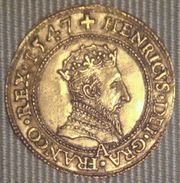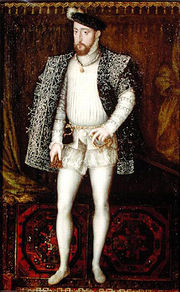Henry II of France
- Henry II of France redirects here. It can also refer controversially to Henry VI of England.
| Henry II | |
|---|---|
 |
|
|
|
|
| Reign | 31 March 1547 – 10 July 1559 |
| Coronation | 25 July 1547 |
| Predecessor | Francis I |
| Successor | Francis II |
| Spouse | Catherine de' Medici |
| Issue | |
| Francis II of France Elisabeth, Queen of Spain Claude, Duchess of Lorraine Charles IX of France Henry III of France Margaret, Queen of Navarre and France Francis, Duke of Anjou |
|
| House | House of Valois |
| Father | Francis I of France |
| Mother | Claude, Duchess of Brittany |
| Born | 31 March 1519 Saint-Germain-en-Laye, France |
| Died | 10 July 1559 (aged 40) Paris, France |
| Burial | Saint Denis Basilica, France |
Henry II (31 March 1519 – 10 July 1559) was King of France from 31 March 1547, until his death in 1559.[1]
Contents |
Reign

Henry's reign was marked by wars with Austria, and the persecution of the Protestant Huguenots. Henry II severely punished them, particularly the ministers: burning them at the stake or cutting off their tongues for uttering heresies. Even those only suspected of being Huguenots could be imprisoned. The Edict of Châteaubriant (27 June 1551) called upon the civil and ecclesiastical courts to detect and punish all heretics and placed severe restrictions on Huguenots, including the loss of one-third of their property to informers, and confiscations. It also strictly regulated publications by prohibiting the sale, importation or printing of any unapproved book. It was during the reign of Henry II, Huguenot attempts at establishing a colony in Brazil were made, with the short-lived formation of France Antarctique.[2]


The Italian War of 1551–1559, sometimes known as the Habsburg–Valois War, began when Henry declared war against Charles V with the intent of recapturing Italy and ensuring French, rather than Habsburg, domination of European affairs. The continuation of his father's Franco-Ottoman alliance allowed Henry II to push for French conquests towards the Rhine while a Franco-Ottoman fleet defended southern France.[3] An early offensive into Lorraine was successful, with Henry capturing the three episcopal cities of Metz, Toul, and Verdun, but the attempted French invasion of Tuscany in 1553 was defeated at the Battle of Marciano.
After Charles's abdication in 1556 split the Habsburg empire between Philip II of Spain and Ferdinand I, the focus of the war shifted to Flanders, where Phillip, in conjunction with Emmanuel Philibert of Savoy, defeated the French at St. Quentin. England's entry into the war later that year led to the French capture of Calais, and French armies plundered Spanish possessions in the Low Countries. Henry was nonetheless forced to accept the Peace of Cateau-Cambrésis, in which he renounced any further claims to Italy.

The Peace of Cateau-Cambrésis was signed between Elizabeth I of England and Henry on 2 April and between Henry and Philip II of Spain on 3 April 1559 at Le Cateau-Cambrésis, around twenty kilometers southeast of Cambrai. Under its terms, France restored Piedmont and Savoy to the Duke of Savoy, but retained Saluzzo, Calais and the bishoprics of Metz, Toul, and Verdun. Spain retained Franche-Comté. Emmanuel Philibert, Duke of Savoy, married Margaret of France, Duchess of Berry, the sister of Henry II, and Philip II of Spain married Henry's daughter Élisabeth.
Henry raised the young Mary, Queen of Scots, at his court, hoping to use her to ultimately establish a dynastic claim to Scotland. On 24 April 1558, Henry's fourteen-year-old son Francis was married to Mary in a union intended to give the future king of France not only the throne of Scotland but a claim to the throne of England. Henry had Mary sign secret documents, illegal in Scottish law, that would ensure Valois rule in Scotland even if she died without an heir (Guy 2004:91). Mary's claim to the English throne quickly became an issue when Mary I of England died later in 1558, Henry and his Catholic advisors regarding Elizabeth I unfit to reign because of her illegitimacy.
Patent innovation

Henry II introduced the concept of publishing the description of an invention in the form of a patent. The idea was to require an inventor to disclose his invention in exchange for monopoly rights to the patent. The description is called a patent “specification”. The first patent specification was submitted by the inventor Abel Foullon for "Usaige & Description de l'holmetre", (a type of rangefinder.) Publication was delayed until after the patent expired in 1561.[4]
Death

Henry II was an avid hunter and a participant in jousts and tournaments. On 30 June 1559, at the Place des Vosges in Paris, during a match to celebrate the Peace of Cateau-Cambrésis with his longtime enemies, the Habsburgs of Austria, and to celebrate the marriage of his daughter Elisabeth of Valois to King Philip II of Spain, King Henry was mortally wounded by the lance of Gabriel Montgomery, captain of the King's Scottish Guard. The lance pierced his eye and, despite the efforts of royal surgeon Ambroise Paré, he died on 10 July 1559 from septicemia.[5] He was buried in a cadaver tomb in Saint Denis Basilica.

As Henry lay dying, Queen Catherine limited access to his bedside and denied his mistress Diane de Poitiers access to him, even though he repeatedly asked for her. Following his death, Catherine sent Diane into exile, where she lived in comfort on her own properties until her death.
Henry was succeeded by his son, Francis II, who died the following year and was succeeded by his two brothers. Their mother acted as Regent. For the forty years following Henry II's death, France was filled with turbulence as Protestants and Catholics fought the bitter French Wars of Religion.
Ancestors and Descendants
| Ancestors of Henry II of France | ||||||||||||||||||||||||||||||||||||||||||||||||||||||||||||||||||||||||||||||||||||||||||||||||||||||||||||||||||||||||||||||||||||||||||||||||||||||||||||||||||||||||||||||||||||||||||||||||||||||||||||||||||||||||||||||||||||||||||||||||||||||||||||||||||||||||||||||||||||||||||||||||||||||||||||||||||||||||||||||||||||||||||||||||||||||||||||||||||||||||||||||||||||||||||||||||||||||||||||||||||||||||||||||||||||||||||||||||||||||||||||||||||||||||||||||||||||||||||||||||||||||||||||||||||||||||||||||||||||||||||||||||||||||||||||||||||
|---|---|---|---|---|---|---|---|---|---|---|---|---|---|---|---|---|---|---|---|---|---|---|---|---|---|---|---|---|---|---|---|---|---|---|---|---|---|---|---|---|---|---|---|---|---|---|---|---|---|---|---|---|---|---|---|---|---|---|---|---|---|---|---|---|---|---|---|---|---|---|---|---|---|---|---|---|---|---|---|---|---|---|---|---|---|---|---|---|---|---|---|---|---|---|---|---|---|---|---|---|---|---|---|---|---|---|---|---|---|---|---|---|---|---|---|---|---|---|---|---|---|---|---|---|---|---|---|---|---|---|---|---|---|---|---|---|---|---|---|---|---|---|---|---|---|---|---|---|---|---|---|---|---|---|---|---|---|---|---|---|---|---|---|---|---|---|---|---|---|---|---|---|---|---|---|---|---|---|---|---|---|---|---|---|---|---|---|---|---|---|---|---|---|---|---|---|---|---|---|---|---|---|---|---|---|---|---|---|---|---|---|---|---|---|---|---|---|---|---|---|---|---|---|---|---|---|---|---|---|---|---|---|---|---|---|---|---|---|---|---|---|---|---|---|---|---|---|---|---|---|---|---|---|---|---|---|---|---|---|---|---|---|---|---|---|---|---|---|---|---|---|---|---|---|---|---|---|---|---|---|---|---|---|---|---|---|---|---|---|---|---|---|---|---|---|---|---|---|---|---|---|---|---|---|---|---|---|---|---|---|---|---|---|---|---|---|---|---|---|---|---|---|---|---|---|---|---|---|---|---|---|---|---|---|---|---|---|---|---|---|---|---|---|---|---|---|---|---|---|---|---|---|---|---|---|---|---|---|---|---|---|---|---|---|---|---|---|---|---|---|---|---|---|---|---|---|---|---|---|---|---|---|---|---|---|---|---|---|---|---|---|---|---|---|---|---|---|---|---|---|---|---|---|---|---|---|---|---|---|---|---|---|---|---|---|---|---|---|---|---|---|---|---|---|---|---|---|---|---|---|---|---|---|---|---|---|---|---|---|---|---|---|---|---|---|---|---|---|---|---|---|---|---|---|---|---|---|---|---|---|---|---|---|---|---|---|---|---|---|---|---|---|---|---|---|---|---|---|---|---|---|---|---|---|---|---|---|---|---|---|---|---|---|---|---|---|---|---|---|---|---|---|---|---|---|---|---|---|---|---|---|---|---|---|---|---|---|---|---|---|---|---|---|---|---|---|---|---|---|---|---|---|---|---|---|---|---|---|---|---|---|---|---|---|---|---|
|
||||||||||||||||||||||||||||||||||||||||||||||||||||||||||||||||||||||||||||||||||||||||||||||||||||||||||||||||||||||||||||||||||||||||||||||||||||||||||||||||||||||||||||||||||||||||||||||||||||||||||||||||||||||||||||||||||||||||||||||||||||||||||||||||||||||||||||||||||||||||||||||||||||||||||||||||||||||||||||||||||||||||||||||||||||||||||||||||||||||||||||||||||||||||||||||||||||||||||||||||||||||||||||||||||||||||||||||||||||||||||||||||||||||||||||||||||||||||||||||||||||||||||||||||||||||||||||||||||||||||||||||||||||||||||||||||||

See Children of Henry II of France and Catherine de' Medici
Henry II also had four illegitimate children:
- By Catherine Michelle: Elaine de Francias (1557–1635). Henry supposedly debated whether or not to give her a title and only on his deathbed did he admit to being her father. He gave her the title Comtesse de Montmorency. It is not known why he was so secretive about this one daughter.
- By Filippa Duci: Diane, duchesse d'Angoulême (1538–1619). Some sources have stated that the child was the natural daughter of Henry's long-time mistress, Diane de Poitiers. This is probably not the case since it is on record that Henry had Filippa Duci watched closely throughout her pregnancy. She gave birth in a convent and it appears that she remained there for the rest of her life. At the age of fourteen, the younger Diane married Orazio Farnese, Duke of Castro, who died young in battle. Her second marriage was to François, duc de Montmorency.
- By Lady Janet Stewart (1508–1563), herself an illegitimate daughter of James IV of Scotland: Henri de Valois (1551 – June 1586). He was legitimized and became governor of Provence.
- By Nicole de Savigny: a son, Henri (1557–1621). He was given the title of comte de Saint-Rémy. One of his last descendants was Jeanne de Valois-Saint-Rémy, Comtesse de la Motte, famous for her role in the Affair of the Diamond Necklace.
Prophecy
| Royal styles of King Henry II Par la grâce de Dieu, Roi de France |
|
|---|---|
 |
|
| Reference style | His Most Christian Majesty |
| Spoken style | Your Most Christian Majesty |
| Alternative style | Monsieur le Roi |
Nostradamus, a French astrological writer known for his prophecies, is often said to have become famous when one of his quatrains was construed as a prediction of the death of King Henry II:
CI, Q 35 The young lion shall overcome the older one,
on the field of combat in single battle,
He shall pierce his eyes in a golden cage,
Two forces one, then he shall die a cruel death.
But, in fact, the link was first proposed in print only in 1614,[6] fifty-five years after the event and forty-eight after Nostradamus' death; thus it qualifies as a postdiction, or vaticinium ex eventu. The Italian astrologer Luca Gaurico, a contemporary of Nostradamus, is also said to have predicted the king's death.
Notes
- ↑ Patrick, David, and Francis Hindes Groome, Chambers's biographical dictionary: the great of all times and nations, (J.B. Lippincott Company, 1907), 482.
- ↑ France and the Americas: culture, politics, and history Volume 3, By Bill Marshall, Cristina Johnston p.185ff
- ↑ The Cambridge History of Islam, p.328
- ↑ M. Frumkin, "The Origin of Patents", Journal of the Patent Office Society, March 1945, Vol. XXVII, No. 3, pp 143 et Seq.
- ↑ Classic Encyclopedia Web, Based on 1911 Edition of the Encyclopaedia Britannica
- ↑ César Nostradamus, Histoire et Chronique de Provence, Lyon, Simon Rigaud, 1614
References
- Arnold-Baker, Charles, The companion to British history, Routledge, 1996.
- Frumkin, M., The Origin of Patents, Journal of the Patent Office Society, March 1945, Vol. XXVII, No. 3, 143.
- Guy, John, My Heart is my Own, London, Fourth Estate, 2004, ISBN 0–00–71930–8.
- Nostradamus, César, Histoire et Chronique de Provence, Lyon, Simon Rigaud, 1614
- Patrick, David, and Francis Hindes Groome, Chambers's biographical dictionary: the great of all times and nations, J.B. Lippincott Company, 1907.
- Tazón, Juan E., The life and times of Thomas Stukeley (c.1525-78), Ashgate Publishing Ltd, 2003.
|
Henry II of France
House of Valois, Orléans-Angoulême branch
Cadet branch of the Capetian dynasty
Born: 31 March 1519 Died: 10 July 1559 |
||
| Regnal titles | ||
|---|---|---|
| Preceded by Francis I |
King of France 31 March 1547 – 10 July 1559 |
Succeeded by Francis II |
| French royalty | ||
| Preceded by Francis, 15th Dauphin |
Dauphin of France as 'Henry, 16th Dauphin' 10 August 1536 – 31 March 1547 |
Succeeded by Francis, 17th Dauphin |
| Preceded by Francis, Dauphin of France |
Heir to the Throne as Heir apparent 10 August 1536 – 31 March 1547 |
Succeeded by Francis, Dauphin of France |
| French nobility | ||
| Preceded by Francis I |
Count of Provence and Forcalquier as 'Henry I' 31 March 1547 – 10 July 1559 |
Succeeded by Francis II |
| Preceded by Francis IV of Viennois |
Dauphin of Viennois, Count of Valentinois and of Diois as 'Henry I of Viennois' 10 August 1536 – 31 March 1547 |
Succeeded by Francis V of Viennois |
| Preceded by Francis III of Brittany |
Duke of Brittany 10 August 1536 – 31 March 1547 |
Merged in crown |
| Preceded by Vacant (Louis II) |
Duke of Orléans as 'Henry I' 1519–1536 |
Succeeded by Charles II |
|
|||||||||||||||||||||||||||||||||||||||||